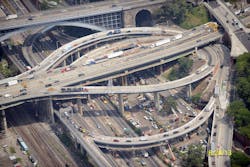2013 Top 10 Bridges - No. 3
Project: Alexander Hamilton Bridge Rehabilitation
Location: Manhattan and Bronx, N.Y.
Owner: New York State DOT
Designer: Jacobs
Contractors: CCA Civil/Halmar International LLC
Cost: $407 million
Start Date: March 2009
Completion Date: December 2013
Back-to-back victory
Crews overcome unexpected delay in largest rehab project in NYSDOT history
Two backs pressing against each other usually creates some leverage. For those involved in the Alexander Hamilton Bridge rehabilitation project in New York City, it weakened the knees of a schedule that was tight from the start.
The floor beams on the arch side of the bridge were back-to-back members of steel. During inspection, workers could not see between them, so when they were finally pulled, the deterioriation was seen firsthand for the first time. It was much worse than expected.
“This deterioration of the floor beams also extended to the interface with the spandrel girders that run longitudinal on the arch portion,” Manual Silva, area construction supervisor for the New York State Department of Transportation (NYSDOT), told Roads & Bridges.
A problem like this is never factored into any schedule, and due to the extent of corrosion a lot of design was required. The contractor needed to draw up a solution, which had to be approved, and also produced a 3-D model of the interface of the floor beams with the spandrel girders.
“That whole process takes so long and involved all of the stages on the schedule,” said Silva.
Work on the bridge was delayed almost 11 months. To help make up time each of the six stages of construction were tweaked. The contractor had what Bruce Ogurek, director of construction for the bridge, called a “priority portion” to the mounds and mounds of shop drawings that needed to be reviewed.
“They sent to the reviewers a weekly priority schedule, so not everything was approved at once, but it never delayed something getting to the job,” he told Roads & Bridges.
Elements of the fix also were assembled at the fabricator, so entire sections could be placed at the jobsite all at once, and at press time the job was back on schedule, with full completion set for Dec. 31.
Keeping traffic moving was the top priority during the largest rehabilitation project in NYSDOT history. More than 200,000 vehicles cross the bridge, and four temporary ramps were constructed. A cantilevered section was added on both the southbound and northbound portions of the bridge to widen the deck, and more space was added between the two structures.
A counterflow lane also helped keep cars moving coming from the westbound direction. Stages four and five called for one-lane reductions, so to keep the flow from clogging crews took advantage of the fact that it was a bi-level bridge.
“You sacrificed one, say you take a lane from the lower level, but you take away a merge condition in the upper level,” said Ogurek. “So with that framework we were able to improve traffic flow.” R&B
